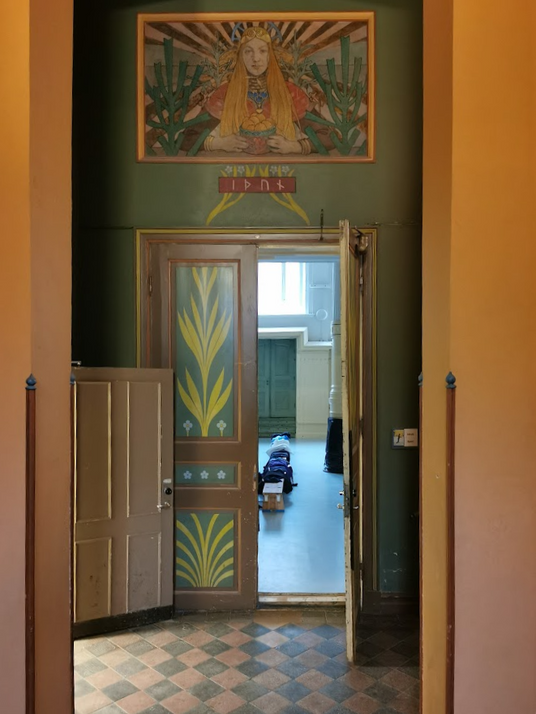Victoriaskolan - a trip to the past
- solvingmysteriesbl
- May 4, 2023
- 3 min read
Let's talk about this really cool building in Göteborg, Sweden ☆

Original Building
In 1888 a new site at Viktoriagatan 28 was assigned to the existing Nya Elementarläroverk för flickor (New Elementary School for Girls) to accommodate 250 students and add a living quarters for the headmaster. The school was founded in 1867 as a school for girls, and moved into the new building in 1889 when the construction was completed.
The building was designed by architect Adrian C. Peterson and built by Nils Andersson & Co construction company. The opening ceremony was held on April 10, 1890. By 1914 the school had grown from the original 52 students to 315. The headmasters quarters and attic had been taken over in 1909 to create more classroom space for students, and extra classrooms were added in the middle of the hallways, but it still wasn’t enough space and plans for building extensions began.
Extensions
The school kept growing and had 485 students by the end of 1923 so they had to immediately add more space and the assembly hall that exists today as the gymnasium was built and completed in 1926. Before this hall was added, the school had to rent out local spaces such as the YMCA to hold large events. The extension additionally included 2 more floors on top of the assembly hall that added 8 classrooms, and the craft room was turned into the large dining room that is also still there today.

Exterior view of the 1924 extension
Because of the extension, the school grew again to around 650 students and ran successfully until it was municipalized in 1946. Municipalization is when the ownership of a building changes from a person to a city, like Göteborg. The city changed the name to “Göteborgs nya elementarläroverk” but it remained a girls school until 1967 when it closed. Göteborg Skolmuseum moved its collection into the building until 1993, then it became a school again. The name of the school changed again to Engelbrektsskolan, then the German School, and today it is called Victoriaskolan.
The school in 1910 versus today. The extension on the right is very visible here.
Art
The real beauty of this building is the unique artwork by Carl Larsson in the main stairwell also known as the “Carl Larsson Stairwell”. Carl Larsson is one of Sweden's most beloved artists.
The stairwell in the past versus today (src:https://kringla.nu/kringla/objekt;jsessionid=B43ED5F2F0502A3389299F62460BFC9A?referens=GSM/name/163816)
Carl Larsson was born on May 28th, 1853 in Stockholm. At 13 he attended an art academy, then worked as an illustrator for books, magazines, and newspapers.
Carl Larsson signature on the Victoriaskolan stairwell
He began with oil painting, then changed to watercolors primarily, but he believed his large scale frescoes in public buildings, like Victoriaskolan, were more important than his watercolor works.

Carl Larsson painting the stairwell
The person funding the project at Victoriaskolan supposedly said "Give her a small painting above the first door, this horrible house is not worth more!" but Carl Larsson was excited about the project and created sketches and completed the project anyway.
Sketch of gymnasium door from Carl Larsson book (on right) versus actual gymnasium door
(src: https://auctionet.com/en/2540514-bok-svenska-kvinnan-genom-seklen-stockholm-1909/images#image_1)
The art in Victoriaskolan represents “The Swedish Woman through the Centuries” and features 10 scenes of Swedish women living through different time periods from the bronze age to today.
Clocktower
The building also features a large clocktower. Visiting the attic reveals the fascinating inner workings of the clock. The clock at Victoriaskolan was built by Linderoth Urfabrik, a clock factory in Stockholm. Linderoth Urfabrik was founded in 1844 by Gustaf Wilhelm Linderoth.

Linderoth tower clock at Victoriaskolan
Linderoth started with small clocks such as pocket watches and wall clocks. In 1853 he built a tower clock for the king of Sweden, then began building more large tower clocks and eventually built around 500 of these. The company was taken over by his son Johan Gustaf Linderoth in 1871, and the company continued making clocks of all sizes until 1963. The tower clock in Victoriaskolan was built in 1895, and is still operational to this day.
Fun fact: although the clock is operational, it has been disabled due to noise complaints in the neighborhood from the hourly chime.
History is Everywhere
This building is still used today as a school for students from preschool to year 9. Surrounding the students every day is all this unique history in just one building. How many other hidden treasures are waiting to be found in buildings just like this? I'm so endlessly inspired by the little mysteries of everyday life like this.
Useful Sites For Exploring Victoriaskolan history:

_edited.jpg)









































Comments